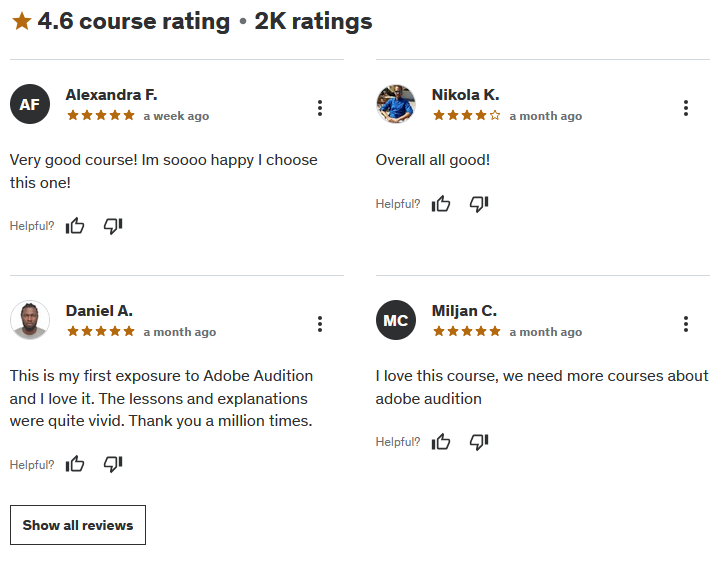If you’re new to Adobe Audition or just getting started with audio editing, this Udemy course, “Adobe Audition CC: The Beginner’s Guide to Adobe Audition“, could be just what you’re looking for. It promises to take you from novice to someone who can comfortably record, edit, and mix audio like a pro, all with easy-to-follow tutorials. Whether you’re a podcaster, musician, or video creator, there’s something here for you.
Instructor Reputation
Nader Nadernejad, the lead instructor of this course, brings a wealth of practical experience to the table, which sets him apart from many other online instructors. His background as a multimedia producer, digital marketing expert, and DJ adds a level of real-world credibility that many learners will appreciate. Nader’s teaching style is informed by his own extensive experience in various media formats, including television, radio, and print. This makes him particularly adept at breaking down complex concepts into easily digestible chunks, perfect for beginners who may feel overwhelmed by the technical nature of audio production.

One of the most notable aspects of Nader’s teaching is his ability to connect with students in a way that feels genuine and relatable. He’s not just a technical expert throwing jargon at you—he’s someone who’s been in the trenches and learned through trial and error. His personal story, from facing rejection to building a successful career in multimedia, resonates with students who are looking to carve out their own path in the creative industry. This “learn by doing” mentality is woven into the course itself, where Nader emphasizes practical application alongside theory.
On top of Nader’s contributions, Phil Ebiner, the course producer, is a well-known name in the world of online education, particularly on Udemy. With over 500,000 students across various courses, Phil’s involvement adds an extra layer of trust in the course’s quality. His reputation for creating structured, clear, and high-quality educational content precedes him, and his partnership with Nader ensures that you’re getting both creative expertise and educational rigor.
In the world of online learning, instructor engagement is crucial, and Nader is not the type to leave students hanging. Whether it’s through the Q&A section of the course or direct messages, Nader is known for being responsive and approachable. His commitment to helping students succeed is evident, and he makes it clear from the start that he’s available to guide you along your learning journey. This level of instructor involvement can be a game-changer for students who need that extra bit of support to fully grasp the course material.
In short, Nader Nadernejad’s extensive experience, coupled with Phil Ebiner’s track record for delivering high-quality courses, makes this course a standout choice for anyone looking to dive into Adobe Audition with the guidance of seasoned professionals.
Course Structure
One of the first things you’ll notice about “Adobe Audition CC: The Beginner’s Guide to Adobe Audition” course is how thoughtfully it’s structured. It’s not just a series of random lessons cobbled together; instead, it follows a logical progression that takes you from the very basics of Adobe Audition all the way through to mastering more advanced audio editing techniques. For a beginner, this kind of structure is invaluable because it allows you to build on what you’ve learned in previous lessons, making the learning curve feel much more manageable.

The course begins with an introduction to the Adobe Audition interface, which is key for any beginner who might feel intimidated by the software’s array of tools and options. Nader does a great job of walking you through each element of the interface, explaining what each tool is used for and how it fits into the larger workflow of audio editing. This foundation is crucial because, without a clear understanding of the interface, more advanced tasks can feel overwhelming. By the end of the first few lessons, you’ll feel confident navigating Audition’s workspace, which sets the tone for the rest of the course.
Once you’re comfortable with the interface, the course transitions into more hands-on activities. You’ll start by learning how to record audio, which includes everything from setting up your microphone to adjusting input levels to ensure clean, professional-quality sound. Nader takes the time to explain not just how to record, but also why certain techniques matter, offering context that helps deepen your understanding of audio production. For example, he goes over how to avoid common pitfalls like background noise or audio clipping, both of which are essential skills for anyone working with audio.
As you move forward, the lessons delve into editing techniques that are applicable across a wide range of projects, whether you’re working on a podcast, a music track, or voice-over for a video. You’ll learn how to trim and cut audio clips, add transitions, and layer different tracks to create a more dynamic sound. The course also covers the essential tools for improving sound quality, such as EQ adjustments, noise reduction, and audio compression. Nader walks you through each of these techniques step-by-step, providing clear explanations that make even complex tasks feel approachable.
The structure of the course also allows for a lot of flexibility. If you’re only interested in certain aspects of audio editing—like podcast production or music mixing—you can jump straight to the relevant sections without feeling like you’re missing out. However, for those who prefer to follow the course sequentially, the lessons flow seamlessly from one topic to the next. Each new skill builds on the last, allowing you to grow more confident in your abilities as you progress.
Another strong point is the course’s inclusion of practical exercises. You’re not just passively watching Nader edit audio; you’re actively encouraged to follow along with your own projects. The course provides practice audio files, so you can replicate the steps shown in the lessons on your own computer. This kind of hands-on learning is incredibly effective because it forces you to engage with the material and troubleshoot issues in real-time. By the time you’ve completed the course, you’ll have not only learned how to use Adobe Audition but also created your own projects from scratch.
Lastly, the course doesn’t skimp on more advanced techniques. Once you’ve mastered the basics, you’ll learn how to apply effects, mix multiple tracks, and even master your audio for online platforms. The lessons on DJ drops, time-stretching, and vocal adjustments offer creative tools that can help you stand out in the world of audio production. Whether you’re editing a podcast, producing music, or working on sound design for a video, these advanced skills will help elevate your work to a professional level.
In summary, the course is designed in a way that makes it accessible for beginners while still offering depth for more advanced users. The clear progression from basic to advanced topics, combined with hands-on exercises, ensures that you not only learn how to use Adobe Audition but also gain the confidence to apply these skills to your own projects.
Content Quality
When it comes to the content quality of the course, “Adobe Audition CC: The Beginner’s Guide to Adobe Audition” doesn’t disappoint. From start to finish, the course offers well-produced, clear, and highly practical lessons that strike a balance between technical depth and user-friendly explanations. Each lesson is designed to not only teach you the tools of Adobe Audition but also help you understand why you’re using those tools in the first place, which is key for anyone looking to develop a deeper understanding of audio editing.

One of the course’s standout features is its focus on real-world applications. You aren’t just learning the technical side of things; you’re also gaining insights into how Adobe Audition is used in various professional environments, from podcast production to music editing and beyond. For example, in the lessons on background noise reduction and vocal enhancement, Nader doesn’t just walk you through the steps—he explains the underlying principles, such as how frequencies work in sound engineering. This kind of detailed yet accessible teaching is rare, especially in online courses targeted at beginners.
Another strength is the course’s attention to detail. Each lesson is methodically broken down into digestible chunks, so even the most complex topics feel manageable. For instance, when you dive into the more advanced aspects like audio compression, EQ adjustments, or mastering, you’re not left feeling overwhelmed by jargon. Nader does a great job of explaining each concept clearly, with a focus on how these techniques will improve your overall audio quality. He also provides side-by-side examples of raw versus edited audio, making it easy to see the practical results of your efforts.
The inclusion of hands-on exercises also adds immense value. The course provides downloadable audio files that allow you to practice alongside the lessons, ensuring that you’re not just watching but actively engaging with the content. This hands-on approach is crucial for developing muscle memory when navigating Adobe Audition’s interface and using its wide array of tools. Being able to immediately apply what you’ve learned in a real-world context cements the skills, making them easier to recall when you’re working on your own projects later.
Where the content truly shines is in its adaptability. Whether you’re looking to clean up audio for YouTube, mix tracks for a podcast, or work on music production, the course has something for everyone. Nader covers the essentials like removing unwanted noise and making vocals sound crisper, but he also dives into niche topics like DJ drops and looping songs, which can be incredibly useful for more specific types of audio work. This makes the course versatile enough to appeal to a wide range of learners, from aspiring podcasters to seasoned audio editors looking to sharpen their skills.
One minor area of improvement could be the inclusion of more advanced project files for certain sections. While the practice audio provided is sufficient for learning basic and intermediate skills, more advanced students might find themselves wanting for more challenging material. Some students mentioned that they couldn’t fully follow along with certain sections because they didn’t have access to the exact audio files Nader was using in his demonstrations. This might be a small limitation for those who want to dig deeper into advanced techniques, but for the majority of beginners, the content is more than enough to get started and build confidence in their skills.
Overall, the content is rich, comprehensive, and designed to accommodate learners of all skill levels. Whether you’re just dipping your toes into audio editing or looking to polish your existing skills, this course offers a wealth of knowledge that’s applicable across different industries and projects.
Overall Course Rating – 8.5/10
When it comes to assessing “Adobe Audition CC: The Beginner’s Guide to Adobe Audition“, it’s clear that this course delivers tremendous value, especially for beginners. I would comfortably give it an overall rating of 8.5/10. The course offers a well-rounded, structured learning experience that covers both the basics and more advanced techniques of audio editing, all while maintaining an easy-to-follow format. The approachable teaching style of Nader Nadernejad, combined with Phil Ebiner’s top-tier course production, makes this course an excellent starting point for anyone new to Adobe Audition.

The primary strength of this course lies in its accessibility. Whether you’re a complete novice or someone with limited experience in audio editing, the course walks you through each step in a way that never feels rushed or overly complicated. The pacing is just right, allowing you to absorb each concept before moving on to the next. The inclusion of practice files and hands-on exercises really sets this course apart because it ensures that you’re not just passively learning but actively developing skills that you can immediately apply. This practical approach is a huge reason for the high rating, as it truly empowers students to go beyond just watching the lessons.
While the course is incredibly strong for beginners, it’s also structured in such a way that intermediate learners can extract a lot of value from the more advanced sections. Techniques like EQ adjustments, time-stretching, and mastering are explained with a depth that even more experienced users will find useful. However, those already well-versed in audio production might find the early portions of the course a bit too basic, which is something to consider if you’re looking for highly advanced techniques right from the start. For complete beginners, though, the foundation this course builds is excellent.
That said, the course isn’t without minor flaws. Some students have noted that not all the project files used in the lessons were available for download, which can make it difficult to follow along during more advanced sections. Additionally, while the course covers a wide range of topics, there are areas where more depth could have been provided—particularly when it comes to certain advanced features of Adobe Audition. For example, more time could have been spent exploring multi-track editing or more niche aspects like mastering for specific platforms, which would have added even more value for users looking to specialize in those areas.
Despite these small drawbacks, the overall quality of the course is excellent. Nader’s teaching is engaging and clear, and his practical tips ensure that students not only learn how to use Adobe Audition but also understand how to use it effectively in real-world scenarios. His responsiveness in the Q&A section and his commitment to helping students succeed further elevates the course experience. For anyone looking to break into the world of audio editing, or simply improve their existing skills, this course is a fantastic option.
In conclusion, Adobe Audition CC: The Beginner’s Guide to Adobe Audition earns a well-deserved 8.5/10 for its strong content, clear instruction, and practical exercises. While there’s room for slight improvements in providing more advanced project materials and deeper dives into specific topics, the course stands as a robust learning resource that will equip you with the skills to confidently tackle audio editing projects.



